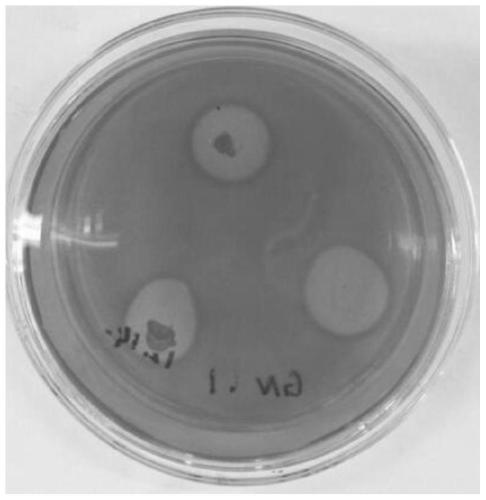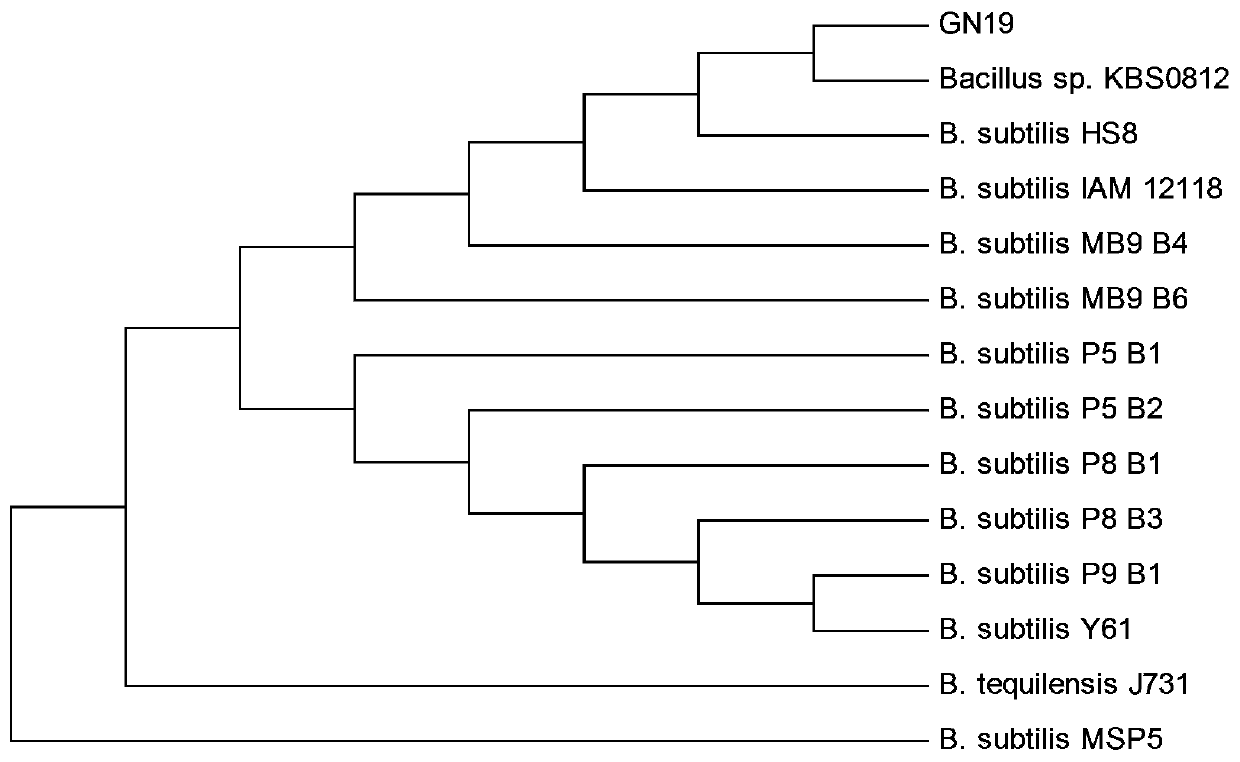Bacillus subtilis with antagonism and capable of degrading cellulose at low temperature and application of bacillus subtilis
A Bacillus subtilis, cellulose-degrading technology, applied in applications, chemicals for biological control, bacteria, etc., can solve problems such as broad-spectrum antagonism and different antagonistic abilities
- Summary
- Abstract
- Description
- Claims
- Application Information
AI Technical Summary
Problems solved by technology
Method used
Image
Examples
Embodiment 1
[0019] The screening and identification process of Bacillus subtilis involved in the present invention are as follows:
[0020] 1. Screening of strains
[0021] Take the straw from the stacked straw pile, rinse the surface with sterile water, spread the rinsed liquid on the beef extract peptone medium, and cultivate it at 15°C.
[0022] 2. Preliminary screening of cellulose degrading strains
[0023] (1) Congo red staining: Inoculate the strains on the beef extract peptone medium onto the sodium carboxymethylcellulose plate by spot inoculation method, inoculate 3 spots on each plate, culture at 15°C for 3 days, and then inoculate with 1 mg / mL Congo red staining solution was used for staining for 30 minutes, the dyeing solution was discarded, and 1mol / L NaCl solution was added to decolorize for 20 minutes. Observe whether there is a hydrolysis circle near the bacterial colony, if there is, it means that the strain has the ability to degrade cellulose, and record the size of t...
Embodiment 2
[0035] In this embodiment, cellulase activity was measured on GN19, and the process was as follows:
[0036] Inoculate the primary screened strains into the seed culture medium, and cultivate them at 15°C and 150r / min for 12h to obtain the seed liquid. The seed solution was inoculated into 100mL liquid fermentation medium at 2%, and cultivated under the same conditions for 72h. The obtained fermentation liquid was centrifuged at 4°C and 10,000 r / min at high speed for 15 min, and the supernatant was collected to be the crude enzyme liquid.
[0037] (1) Endoglucanase activity: get 4 test tubes, 1 as a control and 3 as a test tube, add 1.5 mL of 1% CMC-Na solution respectively, add 0.5 mL of crude enzyme solution in the test tube, wherein Add 2mL DNS to the control to inactivate the enzyme activity, and react at 50°C for 30min. After the reaction, add 2mL DNS to the 3 test tubes to terminate the reaction, shake well and then boil in water bath for 10min, distill the volume to 2...
Embodiment 3
[0045] In this embodiment, antagonism test is carried out on GN19 bacterial strain, and the process is as follows:
[0046] Inoculate the plant pathogenic bacteria cake in the center of the PDA solid medium, use a toothpick to pick up Bacillus subtilis GN19 at a distance of 2cm from the pathogenic bacteria cake, directly inoculate the pathogenic bacteria cake as a control, and culture at a constant temperature of 28°C for 3 to 7 days, measure the radius of the colony, and calculate the antibacterial effect rate, the results are shown in Table 3, with another Bacillus subtilis DN5 as a comparison.
[0047] Bacterial inhibition rate = [(control colony radius - treatment colony radius) / control colony radius] × 100%
[0048] Table 3 Inhibitory rate of Bacillus subtilis GN19
[0049]
[0050]
[0051] It can be seen from the above table that the GN19 strain has an antagonistic effect on a variety of pathogenic bacteria, especially the bacteriostatic rate of Sclerotinia scler...
PUM
 Login to View More
Login to View More Abstract
Description
Claims
Application Information
 Login to View More
Login to View More - R&D Engineer
- R&D Manager
- IP Professional
- Industry Leading Data Capabilities
- Powerful AI technology
- Patent DNA Extraction
Browse by: Latest US Patents, China's latest patents, Technical Efficacy Thesaurus, Application Domain, Technology Topic, Popular Technical Reports.
© 2024 PatSnap. All rights reserved.Legal|Privacy policy|Modern Slavery Act Transparency Statement|Sitemap|About US| Contact US: help@patsnap.com










